#Patrizia Caravaggio
Explore tagged Tumblr posts
Text
RACCONTAMI Il percorso di un pensiero, negli scatti di sei fotografe italiane, in mostra a Selvazzano

View On WordPress
#ALESSANDRA MERISIO#ANTONELLA CIVERA#FABRIZIO CARON#LUCY FRANCO#Palazzo dei Congressi EUR#PAOLA MISCHIATTI#PATRIZIA CARAVAGGIO#ROBERTA LOTTO
0 notes
Text
NEM Submissions July 2021 - curator Jane Schultz.
"Excuse my absence here. Life gets ahead of us sometimes and it did to me, enjoying the sunshine and seeing friends and family again. I hope the same has been there for you and the summer is shining good things on you. For the next while, we will go without theme and I will post images that go to my heart instead. Thank you all for supporting this page despite my absence. Andrea and I continue to be overwhelmed by your talent and creativity. For this selection, I went back over the last several months, so some are older and others are newer. Enjoy." -- Jane Schultz
FEATURED WORKS BY: Susie Leff, Deb Field, Vicki Cooper, Rita Colantonio, Jo Sullivan, Fatma Korkut, Patrizia Caravaggio, Joyce Campbell, Judy Lurie Wahlberg, Clint Cline, Robi Gallardo and Janis Brandenburg Lee.
#Jane Schultz#Susie Leff#Deb Field#Vicki Cooper#Rita Colantonio#Jo Sullivan#Fatma Korkut#Patrizia Caravaggio#Joyce Campbell#Judy Lurie Wahlberg#Clint Cline#Robi Gallardo#Janis Brandenburg Lee
0 notes
Text
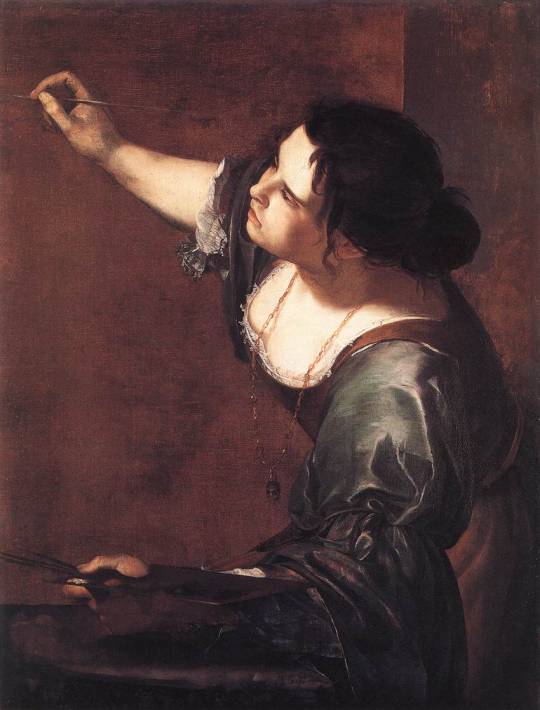
By: Amy Fredrickson
Artemisia Gentileschi was born on July 8, 1593, in Rome and is one of the most distinguished artists of her generation. She challenged the societal limitations placed on female artists during her time and became a successful history painter in her own right. Her career took her from Rome to Florence, Venice, London, and Naples, where she worked for elite patrons such as the Medici family in Florence and King Philip IV of Spain.
Artemisia was the eldest of Prudenzia Montoni and Orazio Lomi Gentileschi’s (1563–1639) five children as well as their only daughter. She was born into an artistic family. In addition to her father, her grandfather Baccio Lomi (c.1550–1595) and her uncle Aurelio Lomi (1556 – 1622) were well-known Pisan painters.
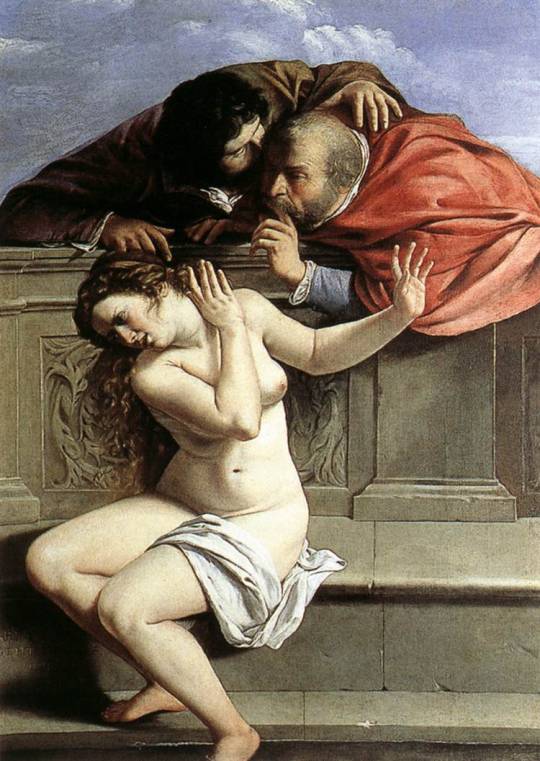
Originally a mannerist-style painter, Orazio became a follower of Caravaggio’s practice of working from nature, and he trained Artemisia to paint in this manner. As a child, Artemisia worked in his studio, mixing pigments and making varnishes. She learned the techniques of chiaroscuro, which was characteristic of Caravaggist paintings. In turn, Artemisia was a second-generation champion of Caravaggio’s realism; her first recorded paintings are almost indistinguishable from her father’s, such as Susanna and the Elders (1610). Painted a few years later, Judith and Her Maidservant (c.1614-20) in the Palazzo Pitti sets her apart from Orazio for its emotive protagonists and deep tenebrism.
Orazio hired painter Agostino Tassi (1578 – 1644) to tutor Artemisia. In the spring of 1611, Tassi raped her, and he refused to fulfill his promise to marry her. Orazio took him to trial because the crime against his daughter was a crime against his family’s honor. Artemisia’s infamous 1612 trial was well-documented and lasted seven months. She was forced to provide a testimony under torture. Found guilty, Tassi was sentenced to banishment from Rome for five months; however, his punishment was not enforced.
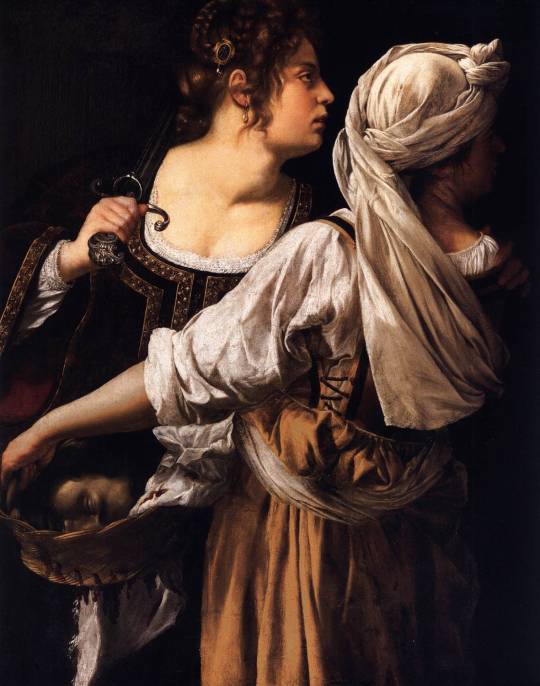
Shortly after, Artemisia married Florentine artist Pietro Antonio di Vincenzo Stiattes (b.1584), and they moved to Florence. Before their arrival, Orazio wrote to the dowager Grand Duchess of Tuscany, Christina of Lorraine, requesting her help in preventing Agostino Tassi's release from the Corte Savella where he was being jailed. In return, Orazio offered to send her one of Artemisia's paintings, Judith and Her Maidservant (c.1614-20).
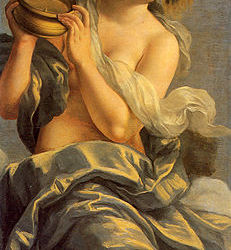
Artemisia established herself as an independent artist in Florence, and she began developing her distinct style. She pushed against the societal norms established for women during her time, such as relegating women painters to the genre of still life or portraiture. Instead, she concentrated on history painting. She established herself within Florentine literary circles, which led to commissions from the Medici family and Michelangelo Buonarotti the Younger. She painted Judith and Holofernes (c. 1612–1621) and the Penitent Mary Magdalene (1620–1625) in the Palazzo Pitti for the Medicis, and for Casa Buonarotti, she painted a ceiling painting called the Allegory of Inclination (1615–1617). Her Florentine paintings illustrate her development beyond her father’s teachings and those of Caravaggio as she introduced a more polished surface, brighter colors, and sophisticated iconography. Perhaps these advances were a product of her association with the poets, painters, and intellectuals she had encountered in Florence. In 1616, Artemisia became the first female member of the Accademia delle Arti del Disegno.

Artemisia was business savvy; she ran her own studio and controlled her finances. The move to Rome may have coincided with Grand Duke Cosimo II de’ Medici’s death in 1621. His successor was Ferdinando, his ten-year-old son, who was governed by his mother and grandmother, and ultimately, their tastes leaned toward penitent biblical figures rather than Artemisia’s bloodletting heroines.
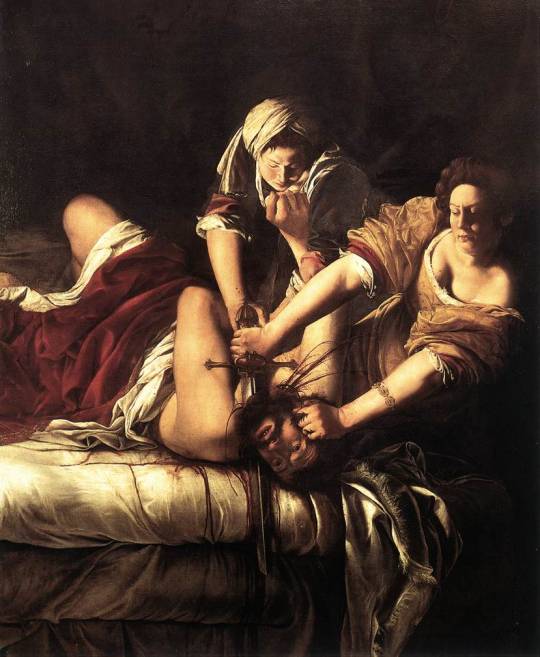
In 1620, Artemisia and her husband returned to Rome for approximately six years. Judith and her Maidservant (c. 1623-25), now in Detroit, dates to this time, although how many paintings Artemisia produced during her second Roman period is unclear. Little is known about her involvement in Roman artistic circles of this period, yet Simon Vouet’s portrait of Artemisia for the papal secretary Cassiano dal Pozzo provides some insight that she was associated with an elite circle of patrons and possibly the Academy of the Desiosi.
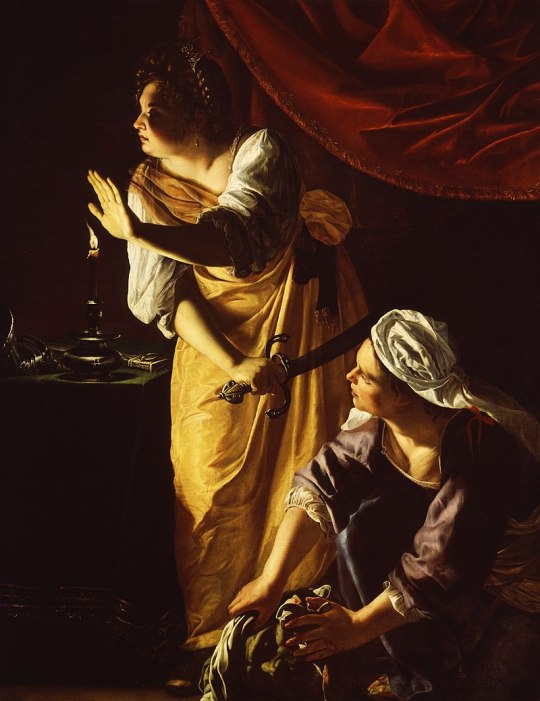
In 1627, Artemisia traveled to Venice for a few years to possibly attain commissions. During her Venetian sojourn, she participated in literary circles such as the Accademia degli Incogniti. Venetian poetry of this time alludes to her status in these circles. While in Venice, Artemisia began to specialize in monumental biblical and historic women; the subject of these paintings featured the triumphs and tragedies of these heroines.

In 1629, the Spanish viceroy, the Duke of Alcalá, invited Artemisia to Naples, and a year later, she resided in Naples and ran a successful studio. A remarkable example of this period is her Esther before Ahasuerus (1627-1630), which hints at her Venetian sojourn. The incorporated grandiose movements and ornamental dress emit an operatic air.
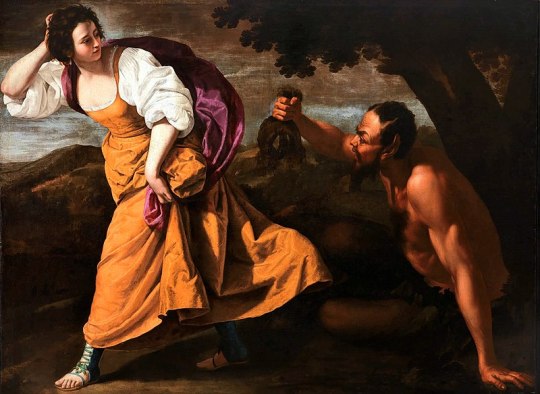
Her recently discovered paintings, such as Corsica and the Satyr (c. 1630-35) and Christ and the Samaritan Women (c. 1637), reveal that the 1630s marked a high point in her career. What sets these works apart from her earlier paintings are her lyrical subjects and the loose Venetian-inspired brushwork of broad white strokes with colors applied on top. During the 1630s, she began incorporating rich colors, such as ochres, blues, and cinnabar red. Artemisia created dimension and drama through her use of such rich hues.

Artemisia left Naples in 1638 to assist her ill father in London. Orazio worked for the English court beginning in 1626 and was working on ceiling paintings for the Great Hall in the Queen’s House in Greenwich. By 1640, she returned to Naples, where she remained until her death. It is unknown when she died, but a recently discovered document shows her living in Naples in August 1654. It is plausible that Artemisia died during the 1656 plague that had ravaged Naples and killed half of its inhabitants.
Images:
Self-Portrait as the Allegory of Painting, c.1630, oil on canvas, 96,5 x 73,7 cm., Royal Collection, Windsor
Susanna and the Elders, 1610, oil on canvas, 170 x 121 cm., Schloss Weissenstein, Pommersfelden
Judith and Her Maidservant, c.1614-20, oil on canvas, 114 x 93.5 cm., Galleria Palatina (Palazzo Pitti), Florence
Allegory of Inclination, c. 1615, oil on canvas (ceiling), 152 cm × 61 cm., Casa Buonarroti, Florence
The Penitent Mary Magdalen, 1620-25, oil on canvas, 146 x 109 cm., Galleria Palatina (Palazzo Pitti), Florence
Judith Beheading Holofernes, 1612-21, oil on canvas, 199 x 162 cm., Galleria degli Uffizi, Florence
Judith and her Maidservant, c. 1623–1625, oil on canvas, 184 x 141.6 cm., Detroit Institute of Art.
Esther Before Ahasuerus, c. 1627-1630, oil on canvas, 208.3 cm x 273.7 cm., Metropolitan Museum of Art.
Corsica and the Satyr, c.1630-35, oil on canvas, 155 x 210 cm., Private Collection.
Christ and the Samaritan Women, c. 1637, oil on canvas, 267.5 x 206 cm., Private Collection.
References:
Sheila Barker, 'Artemisia's Money: The Entrepreneurship of a Women Artist in Seventeenth-Century Florence,' Artemisia Gentileschi in a Changing Light, ed. by Sheila Barker (London, 2018), pp 59-88
Breeze Barrington, 25 April 2020, "The Trials And Triumphs Of Artemisia Gentileschi," Apollo Magazine. [online] <https://www.apollo magazine.com/artemisia-gentileschi-london/>
Ward R. Bissell, Artemisia and the Authority of Art: Critical Reading and Catalogue Raisonné (University Park, 1999)
Ward R. Bissell,‘Artemisia Gentileschi-A New Documented Chronology,’ The Art Bulletin 50, no. 2, (1968), pp. 153–168.
Patrizia Costa, ‘Artemisia Gentileschi in Venice’, Source: Notes in the History of Art 19, no. 3, (2000), pp. 28-36
Mary D. Garrard, 'Artemisia Gentileschi's 'Corisca and the Satyr,'' The Burlington Magazine 135, no. 1078 (1993), pp. 34-38
Mary D. Garrard, Artemisia Gentileschi: The Image of the Female Hero in Italian Baroque Art (Princeton, 1989)
Jesse Locker, Artemisia Gentileschi: The Language of Painting (New Haven, 2015)
#artemisia#artemisia gentileschi#florence#rome#caravaggisti#Caravaggio#Baroque Art#women artists#female artist#heroines#judith#judith and holofernes#susanna and the elders#self portrait
49 notes
·
View notes
Text
“The praise of the beloved’s black mane, commending metonymically a part of the female body for the whole, reduces the woman to an object of minute observation and a vehicle for metaphoric invention.
We have come to the point of dissolution of the descriptive praise that includes the various body parts. Choosing a single part of the woman’s body to symbolize her beauty pushes to the extreme the process of objectification and fragmentation that inevitably mars verbal female portraits.”
“...In the seventeenth century dark ladies were becoming more and more attractive to lyric poets across Europe. Shakespeare’s cycle of Sonnets (1609) in praise of the Dark Lady is perhaps the most eminent example. Shakespeare opens his sequence on the Dark Lady (sonnet 127) by stating the change in the concept of female beauty from fair to black:
In the old age black was not counted fair,
or if it were, it bore not beauty’s name,
but now is black beauty’s successive heir
Although Shakespeare’s example provides the great literary theme for a new tradition of baroque poetry, critics have stressed that, because of her betrayal, the Dark Lady’s beauty is tainted by her negativity; she does not serve as a positive model, and confirms the cliche that dark ladies are morally reprehensible or evil.
One possible source of influence on baroque poetry about the dark ladies may be post-Reformation religious iconography, particularly of the Virgin Mary, who at this time begins to be depicted with dark hair. Medieval and Renaissance painting always presents the Virgin Mary as blonde and light-skinned; one need only mention the famous Madonnas of Raphael, Lippi, and Vasari.
However, after the Reformation pictorial representations of the Virgin begin to show her, when not veiled, with dark hair, as in some of the famous paintings by Caravaggio. Literature and painting appear to be leading in the same direction, towards female representations that are more realistic.”
- Patrizia Bettella, “New Perspectives in Baroque Poetry.” in The Ugly Woman: Transgressive Aesthetic Models in Italian Poetry from the Middle Ages to the Baroque
#baroque#history#shakespeare#patrizia bettella#the ugly woman#new perspectives in baroque poetry#beauty
4 notes
·
View notes
Text
"I racconti del disagio" di Luca Maletta, Caravaggio editore. A cura di Patrizia Baglioni
“I racconti del disagio” di Luca Maletta, Caravaggio editore. A cura di Patrizia Baglioni
Non ho mai riflettuto sul disagio, di solito ho un rapporto aperto e diretto con i miei stati d’animo, li incontro, li sviscero e li analizzo con cura. È uno scrupolo di coscienza innato che porto da sempre con me, eppure il disagio… LUCA MALETTA più che spiegarlo il disagio, lo rappresenta attraverso trentaquattro racconti, alcuni brevissimi, perch�� il malcontento spesso è solo questione di…

View On WordPress
1 note
·
View note
Text
An easy and enjoyable Naples in one day walking itinerary, including a detailed Naples map. Picturesque markets, amazing artworks and great street food.
Why visit Naples? It’s a no-brainer: because Naples is one of the most fascinating, peculiar and beautiful towns you may find in Italy, and, in my opinion, in Europe.
It’s an underrated gem you just can’t skip.
I’m not the only one to think it: the number of foreign tourists visiting Naples have been growing double digit for almost ten years.
The reason is simple: savvy travelers will find tons of art, history, culture, local diversity, beauty, sights, great food, warm people… and you’ll need to pass through Naples in any case, on your way to Pompei and the Amalfi coast.
So why not taking a day or so and spend some time to discover this amazing town?
In this post I will answer to some of the most frequent questions about Naples and share a one day walking itinerary in Naples city center, a Unesco Heritage site.
How much time to spend in Naples?
Well… here I must contradict myself: attempting to visit Naples in one day it’s just not possible. There’s no way you can visit a town as rich and fascinating as Naples in less than two or three days!
However, one day is enough to visit Naples old city center, a Unesco Heritage site, taste some of its amazing street food and, of course, eat the original pizza! And you can easily do it on your way to the Amalfi coast and to Pompei.
It could also be your one day in Naples from Cruise ship.
You may supplement your Naples city center walking tour with the exploration of Maschio Angioino and Castel dell’Ovo castles, the royal palace, that Gallery and the Chiaia posh disctrict.
Other highlights are the national museum, where you can admire all the Roman masterpieces discovered in Pompei and Ercolano, and the Certosa di San Martino with its wonderful views.
These sights are marked on the enclosed Naples in One day Google map (click the image to open the map).
Is Naples safe for tourists?
Until the beginning of present century, Naple’s reputation resonated with images of violence, organized crime, dirt, danger: very little tourists, including Italians, would ever think of putting Naples on their bucket list.
But things have changed!
Today Naples is just as safe as any other large European city, and actually safer than many US big towns (based on Numbeo 2018 crime index).
Policeman and even soldiers are present and visible in all touristic sites, and the only annoyance you should really care about are pickpockets. So mind your belongings, don’t wear expensive jewels and watches, don’t put your wallet in your trousers rear pocket, don’t leave your belongings unattended.
There’s generally a lot of people around, even at night. Just stay on the main roads, avoiding small alleys unless you are with a guide, and you’ll be more than safe.
How to visit Naples in one day?
In my view, the best way to visit Naples is a walking tour. You can do your own by just following my suggested itinerary, or join an escorted tour.
An escorted tour is a good option if you still don’t feel 100% comfortable to explore Naples on your own, and if you are interested about detailed explanations about Naples history, culture and way of life. I personally recommend this 3 hours Get Your Guide Naples Tour, I found it very instructive and convenient. It covers also the Maschio Angioino and Royal Palace and gives you an introduction to the historical center, that you can then drill down on your own.
You could also consider a food tour, to discover Naples delicacies beyond Pizza. I can recommend this good food tour from Get your Guide. It will make you taste not only Piazza, but also Cuoppi (fried street food), he different pies, the pasta omelette, the true mozzarella and, of course, the famous Naples coffee and pastries. Click here to check availability and to reserve.
If you are not interested in walking and would like to see as many things as possible in one day, an Hop on – Hop off bus is a great option. You can purchase your Hop On – Hop Off tickets in advance here, so you won’t need to queue when you get to Naples.
What to see in a one day walking itinerary in Naples: the top 15 things to do and see in Naples historical center
Here are the main sights and activities I recommend, you’ll find them plotted on my Naples in one day walking tour map.
1 -Duomo di Napoli (Cattedrale di Santa Maria Assunta)
Start your Naples in one day walking tour from Naples Cathedral, the Duomo. It’s an easy 20 minutes walk from the station.
This wonderful XIV century church is actually know by many names: the Duomo di Napoli, since it’s the most important church in town. The Santa Maria Assunta Cathedral, the official name.
Bust, most of all, it is known as the Duomo di San Gennaro, since it’s here that the saint’s blood is held, and that the saint’s blood liquefaction miracle takes place twice a year. In case it didn’t happen, tradition claims misfortune will hit the town!
Actually there is a second, lesser known, blood liquefaction miracle, Santa Patrizia’s blood, taking place at the San Gregorio Armeno church. More conveniently, the miracle happens every Tuesday…
2 – Caravaggio Painting in Pio Monte della Misericordia
A couple of hundred meters from the Duomo, in the piazzetta Riario Sforza, stays the small Pio Monte della Misericordia church. It’s a small church that shelters one of Caravaggio’s masterpieces, the famous painting “le sette opere della misericordia”. It’s an absolute must if you love classical paintings.
Entance is from 9:00 AM to 6:00 PM Monday – Saturday, 9:00 AM – 2:30 PM on Sundays. You’ll need to purchase a 7,00 € entry ticket.
3 -San Lorenzo Maggiore and its underground excavations
From the Pio Monte della Misericordia church continue walking along via dei Tribunali until Piazza San Gaetano. Many things to be seen here, the first one is San Lorenza Maggiore Church.
It’s a beautiful and imposing XIV century Gothic church, the first one to be build by King Charles I d’Angiò.
Under the church you can visit the remains of the Neapolis Roman Forum, and fascinating introduction to a Pompei visit.
Entry ticket 9 €.
4 – San Gregorio Armeno Nativity Scenes market
From Piazza san Gaetano starts Via Gregorio Armeno, Naples Nativity scenes market.
It’s a fascinating dive into one of Naples most ancient and important traditions. You can actually visit the workshops and admire the nativity scenes artists at work. It’s surely one of the highlights of your Naples Walking tour!
There is also a XVIII century huge nativity scene (as large as a room!) that you can admire for just 1 €.
To know more about Naples nativity scenes market read my post: Naples nativity scenes market: San Gregorio Armeno
5 – Napoli sotterranea – underground Naples
Getting back in San Gaetano square, on the left side of the church, you will notice the entrance to Naples underground tour.
It’s a fascinating itinerary that will bring you 40 meters underneath modern town, to discover the old Roman aqueducts and tanks. Just unbelievable. Actually these huge spaces have been forgotten for century and were rediscovered before WW II, in order to be used as shelters against the allied bombing.
They are now one of the most interesting and fascinating city center attractions. The visit take 1:15 hours and also includes a visit to the remains of the Roman arena. You can pre book your ticket here at no extra cost, skip the line and make sure you get the time slot you want.
Entry tickets cost 10 €, guided tours start at the hour:
Guided tours in Italian: 10:00 AM -11:00 AM -12:00 PM – 1:00 PM – 2:00 PM – 3:00 PM – 4:00 PM – 5:00 PM – 6:00 PM
Guided tours in English 10:00 AM – 12:00 PM -2: 00 PM – 4:00 PM – 6:00 PM
6 – Time for a Pizza?
You may start to be hungry by now, and willing to taste a true Napoli Pizza. There are many places where you can have one in this area, unfortunately most are touristic and crowded.
I suggest you get a little bit off the beaten path and get a pizza at the La figlia del Presidente. This is were the locals go, hardly any tourist here and the Pizza is delicious and cheap!
7 – Spaccanapoli street
The name is a popular usage and means, literally, “Naples splitter”. The name is derived from the fact that it is very long and from above it seems to divide the city in two.
This street is the southernmost of the three decumani, or east-west streets, of the grid of the original Greco-Roman city of Neapolis.
Today, the street officially starts at Piazza Gesù Nuovo and is named Via Benedetto Croce. Moving east, the street changes name to Via S. Biagio dei Librai and then crosses Via Duomo (named for the Cathedral of Naples) and moves beyond the confines of the old center of town.
Spaccanapoli is the main promenade for tourists as it provides access to a number of important sights of the city.
On top of the main sights you can find along this unique street, however the main attraction in my view is to just look around and observe the local life, especially the small details. You will surely enjoy!
And if you are superstitious, don’t get away without “corno” (horn), the traditional Naples lucky charm, the perfect remedy against bad luck!
8 – Edicola di San Domenico Maggiore
Walking along spacca Napoli you will get to the San Domenico Maggiore square and its Edicola, kind of Baroque obelisk. This is one of the most lively places in this area, especially at night. A perfect place to take some rest and to taste Naples traditional pastry: the Babà!
9 – Cappella Sansevero e Cristo velato – veiled Christ museum
This is another highlight of your Naples tour.
The amazing San Severo chapel host one of the most amazing and probably the best known work of art in Naples and one of the greatest sculptures of all times: the Veiled Christ.
That said, all the chapel is impressive, as well as the story about his owner, the Di Sangro Prince. You can get a preview of what you’ll discover by watching this video.
The San Severo chapel is open every day: 9.00 am – 7.00 pm (closed on Tuesdays). Last entry 30 mins before closing, entry ticket 7:00.
Since the chapel is rather small, queues can be long, better to reserveyour tickets in advance on their web site.
10 – Chiesa del Gesu Nuovo
Your next stop is the Gesù Nuovo church, one of the most famous in Naples.
The original and sober facade, actually the converted 15th-century facade of Palazzo Sanseverino, hides the extraordinary baroque extravaganza of the interior.
The church flanks the beautiful Piazza del Gesù Nuovo, a favorite late-night hang-out for students and locals. At its center soars the lavish Guglia dell’Immacolata, an obelisk built between 1747 and 1750.
11 – Santa Chiara church and cloister
A few steps away, Santa Chiara and its wonderful cloister are your next stop.
The monumental complex of Santa Chiara is one of the most important buildings commissioned by Carlo I d’Angiò for the Franciscan order. Built in 1340, it is a rare example of Medieval architecture in Naples.
The fine cloister outside the church is richly decorated with majolica tiles and it is a pure gem of the eighteenth century. Pillars are nicely decorated by vine shoots, flowers, lemons while the seats are decorated with scenes of the city and country life in the eighteenth century.
A lovely place miles away from the bustling old city.
Access to Santa Chiara is free, opening hours every day 7:30 AM 1:00 PM – 4:30 PM- 20:00 PM
You need to purchase a 6 € ticket for the cloister, opening hours 9:30 AM – 5:30 PM from Monday to Saturday, 10:00 AM – 2:30 PM on Sunday.
12 – Street Food at Cicol’e Ricott
Time for food break! Proceeding straight after Piazza del Gesu nuovo, in Via Domenico Capitelli, 5, you will find the amazing Cicol’ e Ricott’ delicacies store.
This is one of the best places I found to taste local foods. You point your finger, chose what you want, pay and either bring it home or eat it on the tables just outside. In this case, you can also ask for a glass of excellent local wine!
13 – Quartieri Spagnoli – the Spanish quarter
Passing Toledo road, you will get to the Spanish Quarter.
This is a neighborhood of dark and small alleys, laid out in the 1600s when the Spanish ruled the Kingdom of Naples.
Today is still a jam-packed quarter of humanity, bustling with noises, smells, colors, scooters and in general Mediterranean happy confusion. In short, the stereotype of Naples as you would expect it.
The Spanish quarter is probably the most characteristic and chaotic part of Naples and it’s definitely worth seeing. It is also the potentially less safe area to visit, so keep an eye on your purse and belongings and don’t wander around there at night.
14 – Toledo Metro Station
Toledo Metro station is part of Naples Metro stations Art Stations program, which involved major artists such as Anish Kapoor, Gae Aulenti and Sol LeWitt.
Toledo Station is themed around water and light and is probably the most amazing of all Naples Metro Stations. TheTelegraph included it in its Europe’s Most Impressive Underground Railway Stations list.
From here you can take the underground back to Napoli Station, just a few stops away, if you want to stop your walking tour at this stage.
15 -Savor Naples street food
Naples has some really amazing street food, so don’t lose the opportunity to try whatever stimulates you: you won’t be disappointed!
If you still have time or if you are staying one more day in Naples, you can continue to the Maschio Angioino castle and to the Palazzo Reale area (yellow pins on my map) or visit the Certosa di San Martino and the Museo Archeologico (red pins on my map).
If you are spending some days in the area you may also be interested to have a look at my posts: Amazing Amalfi coast: best itinerary to discover Amalfi, Positano, Ravello and Capri walking itinerary: breathtaking Faraglioni and Natural Arch.
Enjoy your Naples in one day walking itinerary!
Like Delightfully Italy? So why don’t you support it!
All you need to do is to use Booking.com to book you next trip to Italy or anywhere else. Plus you’ll get the best deal on accommodation available anywhere!
Booking.com
(function(d, sc, u) { var s = d.createElement(sc), p = d.getElementsByTagName(sc)[0]; s.type = 'text/javascript'; s.async = true; s.src = u + '?v=' + (+new Date()); p.parentNode.insertBefore(s,p); })(document, 'script', '//aff.bstatic.com/static/affiliate_base/js/flexiproduct.js');
Delightfullyitaly.com: Italy top destinations and travel itineraries, off the beaten path
Delightfullyitaly.com is the blog for all the ones in love with Italian culture, Italian sights, Italian monuments .. and with Italian food! If you wish to visit Italy for the first time, or if you already discovered Venice, Rome, Florence, the Amalfi coast, but still want more, delightfullyitaly.com is here to disclose to you Italian Must See as well as Italian hidden treasures. And if you like what you read, why not follow delightfullyitaly.com and get free updates?
Naples is one of the most fascinating cities of the Mediterranean. Here is how to visit it in one day.
0 notes
Text
What You Need to Know about Baroque Master Artemisia Gentileschi

Artemisia Gentileschi, Self-Portrait as a Female Martyr, ca. 1615. Photo via Wikimedia Commons.

Self-Portrait as the Allegory of Painting, ca. 1639. Artemisia Gentileschi The Royal Collection, Windsor Castle, England
Women didn’t have many career options in 17th-century Italy. Cultural norms funnelled most of them into one of two life paths: joining a convent or becoming a mother. What’s more, laws dictated that the men in their lives (fathers, husbands, even sons) made decisions and purchases for them.
Few women transcended these restrictions. But the skillful, strong-willed painter Artemisia Gentileschi managed to—against all odds. During her lifetime, from the late 16th-century until the mid-1600s, she built a reputation as one of Europe’s most sought-after artists. Rich patrons, like the Medicis, and preeminent kings, like Charles I of England, commissioned her to create massive, expertly modeled compositions, chock full of her signature subjects: biblical and mythological scenes depicting assertive, authoritative women.
Gentileschi was as self-made and as independent as was conceivable in her time—and she fought hard for it. “You will find the spirit of Caesar in this soul of a woman,” she once wrote of herself in a letter to a patron. In several instances, she freed herself from shackles that had been placed on her (whether literally or figuratively) by men. Most famously, she won a rape trial she brought against her teacher, the elder artist Agostino Tassi, in an era when women’s claims were rarely believed over those of their male counterparts. (Of course, we still contend with this issue today, even in the midst of the #MeToo moment.)
Despite all of this, though, Gentileschi’s legacy has been hard-won. After her death, 18th- and 19th-century scholars all but omitted her from art historical texts. Even when her work was rediscovered, in the early 20th century, literature on it was plagued with misattributions and overly sexualized interpretations that focused on Gentileschi’s assault rather than her artistry.
Despite these hurdles, the artist has more recently risen to the top of the canon as one of the first female artists to have a broad, incisive impact on the art of her time. She’s also influenced decades of artists after her—especially those looking for a masterful and tenacious heroine.
Asserting her artistic voice and assault

Artemisia Gentileschi, Self-portrait (Allegory of Painting), 1637. Photo via Wikimedia Commons.

Artemisia Gentileschi, The Annunciation, 1630. Photo via Wikimedia Commons.
Gentileschi was born in Rome, in 1593, to Prudentia Montoni and painter Orazio Gentileschi. At the time, the dramatic Baroque style pioneered and popularized by Caravaggio was in vogue, and Orazio latched onto it. His studio was a laboratory of exercises in realist figures, theatrical expression, and chiaroscuro.
At a young age, Orazio brought his daughter into his practice as something of an assistant; in the process, she learned her craft. However, it wasn’t Orazio’s intention for Artemisia to become a professional painter. Several times, he tried to send her to the nunnery. This might be because “women’s work remained semi-clandestine and informal, both stimulated by and subordinate to family needs,” as historian Elizabeth Cropper pointed out in an essay accompanying the 2001 exhibition “Orazio and Artemisia Gentileschi.”
(It was even more rare for a non-aristocratic woman, as Gentileschi was, to take up a painting practice in earnest. Successful female artists who came before her, like Sofonisba Anguissola and Lavinia Fontana, were from wealthy families and could afford to paint as a hobby, while their children were cared for by the help.)
But Orazio’s attempts to ferry his daughter into an ecclesiastical future were unsuccessful, and Artemisia remained in the painting studio. Eventually, he accepted her desire to become an artist, and even began promoting her fast-developing skills. In 1612, when Artemisia was still a teenager, Orazio wrote that she had “become so skilled that I can venture to say that today she has no peer.”

Artemisia Gentileschi with Massimo Stanzione, Corsica and the Satyr, between 1630-1635. Photo via Wikimedia Commons.
Artemisia Gentileschi’s first known work (which some scholars have attributed, in part, to her father) was painted in 1610, when she was 17 years old. Titled Susanna and the Elders, the work depicts a biblical story in which a fair, pious wife is ogled by a group of lecherous male elders as she bathes. Though it wasn’t an uncommon subject for artists at the time, Gentileschi rendered it differently than most. In her version, the woman being aggressed—and her response upon discovering that she’s being watched—takes center stage. “Artemisia’s Susanna presents us with an image rare in art, of a three-dimensional female character who is heroic,” Gentileschi’s biographer Mary D. Garrard has explained. Unlike other representations, “the expressive core of Gentileschi’s painting is the heroine’s plight, not the villains’ anticipated pleasure,” Garrard continued.
Early works like this reveal Gentileschi’s mastery of nudes and facial expressions, which launched her reputation in Rome as a wunderkind painter. (Some scholars have noted that Orazio took a problematic approach to promoting his daughter’s work, essentially exoticizing her by emphasizing that she was a female artist, rather than just an artist.)
But interest in Gentileschi would soon shift away from her art and toward a discussion of her body and morality instead, after she was raped and deflowered by her painting instructor, Agostino Tassi, who was also her father’s business partner. In Gentileschi’s account, Tassi grabbed her as she worked on a canvas, yelling: “Not so much painting, not so much painting.” Tassi’s actions seemed informed by a mix of jealousy, lust, and desire to overpower the young woman. “It is as if he was as enraged by her working as he was inflamed by carnal lust: stopping her from working was the first step in his attempt to dominate her,” Cropper suggested in her essay.
A very public and controversial trial ensued, in which Gentileschi was forced to describe her assault in detail. During the trial, she was subjected to sibille, a process in which ropes were tied to her fingers and tightened progressively. The practice was meant to divine whether or not she was telling the truth. After seven months in court, the judged finally ruled in Gentileschi’s favor. Tassi was sentenced to five years in prison, but never actually served time.
The ruling helped preserve Gentileschi’s reputation as an honorable woman and secure a marriage to a Florentine man named Pierantonio Stiattesi. This was necessary in 17th-century Italy (a society governed by the Catholic church) in order to secure her future as a successful painter.
Painting powerful women

Artemisia Gentileschi, Lot and his Daughters, between 1635-1638. Photo via Wikimedia Commons.

Artemisia Gentileschi, Susanna and the Elders, 1610. Photo via Wikimedia Commons.
Soon after the trial, Gentileschi moved to Florence and set up her own studio—away from her father. It was around this time that she began a series of five works depicting the Old Testament story of Judith and Holofernes, in which a woman plots to kill a warlord who’s besieged her town. Under the cover of night, Judith is successful in beheading him.
Again, the theme wasn’t a novel choice for Renaissance or Baroque artists, but Gentileschi’s handling of it was. Some of her predecessors and contemporaries had chosen to portray Judith as a wily temptress; others captured the moment when Judith escaped with Holofernes’s head. Caravaggio, on the other hand, who had a honed a flair for the dramatic, depicted the very moment Holofernes was killed. Gentileschi took a cue from him, but further dramatized the moment by emphasizing Judith’s force and anger.
In Caravaggio’s version, the heroine seems somewhat nervous and disgusted by the murder she’s carrying out. On the other hand, in Gentileschi’s Judith Slaying Holofernes (c. 1620) (which currently hangs at Florence’s Uffizi Gallery), Judith cuts into Holofernes with gusto; her hand grasps his hair and her expression is enraged and resolute. Meanwhile, blood spurts out of her captor’s neck and drips from his bright white bedsheets.
The picture has become her most famous piece—one that’s arguably overshadowed the rest of her practice. Some scholars have tied the painting, and others in which Gentileschi depicted the same scene, tightly to her biography, interpreting it as reaction to her rape—a representation of revenge on Tassi. But others find this reading too simplistic. Scholar Patrizia Cavazzini pointed out in the catalogue for “Orazio and Artemisia Gentileschi” that Gentileschi’s treatment of this narrative more generally represents an “assertion of agency”; while Griselda Pollock, in her 1999 book Differencing the Canon: Feminist Desire and the Writing of Art’s Histories, argued that the painting is evidence of “an active woman who can make art.” Indeed, one of Gentileschi’s versions of Judith doubles as a self-portrait.

Caravaggio, Judith Beheading Holofernes, ca. 1598-1599. Photo via Wikimedia Commons.
Of the roughly 60 paintings that are attributed to Gentileschi today, around 40 of them foreground female figures—usually pulled from biblical or mythological stories. Subjects include particularly emotive, self-assured representations of Mary Magdalene and other powerful female saints, like Saint Catherine, who called for an end to persecution and was known for her persuasive speaking skills. Gentileschi also portrayed allegories like that of Inclination, which is historically represented by female figures.
In a later work, known as Self-Portrait as the Allegory of Painting (1638–39), she boldly used her own visage to embody the act of painting as a whole. As Riccardo Lattuada suggested in the “Orazio and Artemisia Gentileschi” catalogue, “It seems hard to imagine that Artemisia, in making an image of Painting, did not reflect on the special significance this allegory held for her as a woman artist.” What’s more, the work was later purchased by King Charles I of England, one of Europe’s greatest 17th-century collectors.
By the time Gentileschi made Self-Portrait as the Allegory of Painting, she’d received perhaps the greatest honor bestowed upon the era’s painters: induction into the Accademia del Disegno. She was the first woman to receive the distinction and, according to the 2007 catalogue for the exhibition “Italian Women Artists: From Renaissance to Baroque,” it changed the course of her life.
With this badge of honor, Gentileschi could buy paints and supplies without a man’s permission, travel by herself, and even sign contracts. In other words, through painting, she had gained freedom. Gentileschi would go on to separate from her husband and live and work independently, primarily in Naples and London, for the rest of her life. All the while, she supported her two daughters, who also went on to become painters.
A complicated legacy

Judith and Holofernes, ca. 1620. Artemisia Gentileschi Uffizi Gallery, Florence

Artemisia Gentileschi, Allegory of Inclination, ca. 1615. Photo via Wikimedia Commons.
While Gentileschi was one of the most in-demand painters of her age, she had to fight for fair pay and validity, even in her later years. In letters to her patron Don Antonio Ruffo, she snapped back when he haggled over her fee: “I was mortified to hear that you want to deduct one third from the already very low price I had asked,” she wrote. “I am displeased that for the second time I am being treated like a novice. It must be that in your heart Your Lordship finds little merit in me.” In another letter to him, she pushed against implicit sexism: “And now, I’ll show Your Most Illustrious Lordship what a woman can do!”
She seemed to know her impact, though, and took pride in it. Of her legacy, she told her friend, the great philosopher and scientist Galileo, “I have seen myself honored by all the kings and rulers of Europe,” and that her paintings would go on to “provide the evidence of my fame.” With typical aplomb, she reiterated the sentiment to Don Ruffo: “The works will speak for themselves. And with this, I end with the most humble bow.”
After Gentileschi died, however, her work fell into art historical obscurity. It wasn’t until 1916, when Caravaggio scholar Roberto Longhi published an article on both Orazio and Artemisia, that her work slowly made its way into the spotlight again. But Longhi’s wife, Anna Banti, wrote a popular novel based on Gentileschi’s life, Artemisia, published in 1947, and as a result, the artist’s story was sensationalized and focused on her rape. The work of fiction even influenced scholarship. In 1963, historians Rudolf and Margot Wittkower characterized Gentileschi first as a “lascivious and precocious girl” before describing her “highly honorable career as an artist.” Thankfully, these interpretations were rewritten in the 1970s and ’80s by a group of feminist art historians led by Garrard.

Artemisia Gentileschi, Cleopatra, between ca. 1633-1635.
For her part, Garrard wanted to end Gentileschi’s reputation as “the butt of one long historical dirty joke.” In 1976, Gentileschi’s paintings were included in “Women Artists: 1550–1950,” an influential 1976 exhibition at the Los Angeles County Museum of Art, curated by Linda Nochlin and Ann Sutherland Harris. In the show’s catalogue, Sutherland Harris called the Baroque artist “the first woman in the history of western art to make a significant and undeniably important contribution to the art of her time.”
Even today, Gentileschi’s work is the constant subject of reassessment—recent feminist essays have been written deemphasizing the role of rape and assault in readings of her work, in an attempt to portray her as a constantly evolving artist rather than as a victim.
Despite this back and forth, though, Gentileschi’s impact on the history of art—as a woman artist who fought against adversity to pursue a career in painting—is uncontested.
from Artsy News
0 notes